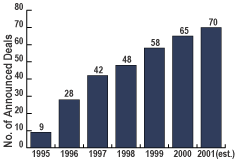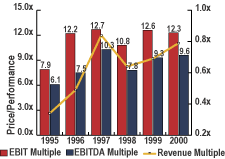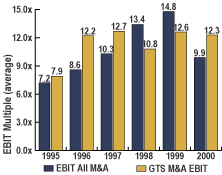Most investors are hiding in underground bunkers by now and have ceased their declarations that each successive market low is a definite buying opportunity. This is particularly true for technology investors with a predominance of focus on the Nasdaq.The Nasdaq composite index has fallen more than 61 percent from its peak in March 2000. The most dramatic declines have occurred in the commercial information technology and communications equipment sectors, which fell by 59 percent and 74 percent, respectively. By comparison, other market indices have dropped less dramatically. In the past year, the Dow Jones Industrials are down about 15 percent and the S&P 500 index is off nearly 26 percent.Contrary to these significant declines is the aerospace and defense sector, which has risen 37 percent, and the government IT group, which has fallen only about 5 percent. Comparing January 1999 to March 2001, the Nasdaq index and the commercial IT industry index have fallen by 14 percent and 50 percent, respectively, while pricing in the government technology and aerospace and defense sectors has risen by 51 percent and 27 percent, respectively.The continuing (relative) strength in the government technology sector is reflected in the robust level of industry merger and acquisition activity. The chart depicting government IT merger and acquisition activity reflects increased deal closings in the last 12 months through March, perpetuating a trend that began in 1996. Pricing multiples ? enterprise value (EV) to earnings before interest and tax (EBIT) and EV to earnings before interest, taxes, depreciation and amortization (EBITDA) ? in reported industry transactions closed in 2000 remained very similar to the average multiples over the past five years at 12 times EBIT and nine times EBITDA. In these measurements, EBIT and EBITDA are actual and unadjusted, rather than pro-forma, numbers.Transactions negotiated since summer 2000, which closed in late 2000 or the first quarter of 2001, reflect the reduced availability of debt financing, as well as the stock price declines experienced by some recently active industry buyers. Some of the buyers that were active in the 1997-1999 period have temporarily suspended acquisition activity to focus on consolidating and refining operations.The market crash in broad-based technology stocks has rational underpinnings considering three things. First, earnings of tech companies are falling far short of expectations. Across a broad array of technology markets, for both services and products, buyers have dramatically slowed the pace and magnitude of their purchases, relative to the pace in the 1997-1999 period. This fall in market demand is especially acute in nongovernment markets, where the post-Y2K and post-Internet bubble environments are very soft.Spending by dot-com and communications start-ups has nearly evaporated, as most of these companies have been unable to raise secondary rounds of financing for their business building strategy. Larger, more financially secure customers are deferring or canceling orders as the perceived need to install more leading-edge technology and become Web-centric has diminished with the demise of the dot-com start-ups. Second, price-to-earnings multiples for many stocks remain too high, relative to revised earnings growth expectations. Near-term market demand for technology products and services will remain sluggish until excess inventories are worked down and the necessity for new product and service spending becomes more compelling. In the longer term, spending growth in technology sectors will pick up steam, but spending is not likely to reach the growth rates implied by recent market pricing multiples.Third, overall market psychology is negative. Factors include rising energy costs, the California power crisis, growing weakness in the manufacturing sector, looming health-care cost escalation, international political unrest and continued economic troubles in Japan. This may sound ominous, but many of these threats were present or anticipated last year.The government technology markets present a contrasting picture of moderate growth, increasing demand and visible cash flows. These attributes reflect stable to increasing budgets, and the continuing requirement for the federal government to re-engineer work flow, implement IT and communications upgrades and migrate processes to a Web-based environment. The prospect of continuing industry consolidation adds to the investment appeal of well-managed companies in the government technology sector.
KEY:
- M&A - merger and acquisition
- EBIT ? earnings before interest and taxes
- EBITDA ? earnings before interest, taxes, depreciation and amortization
- GTS ? government technology sector
Jerry Grossman is managing director at Houlihan Lokey Howard & Zukin in McLean, Va.







